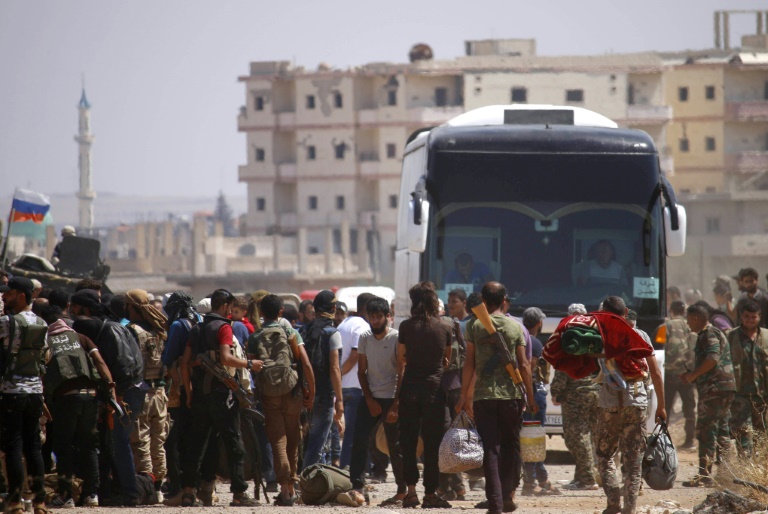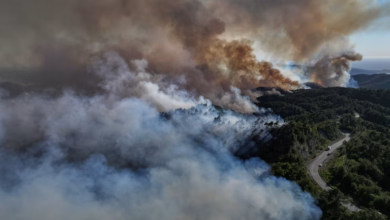
Syrian rebels and their relatives began evacuating the southern city of Daraa on Sunday under a deal to bring the “cradle” of the country’s uprising back under government control.
The highly symbolic transfers came as Russian-backed government forces advanced in the neighboring province of Quneitra, with air strikes pounding rebel positions perilously close to the Israeli-occupied Golan heights.
After securing Damascus in May, President Bashar al-Assad turned his attention to rebels in the strategically vital south, where protests against his rule first erupted seven years ago.
Nearly three weeks of bombardment saw beleaguered rebels agree with Russia earlier this month to hand over Daraa province, before reaching a similar deal for its capital this week.
In recent days, rebels have handed over heavy-duty arms and other equipment to government forces who entered the city’s rebel-held southern districts for the first time in years to plant the national flag.
On Sunday, rebels and civilians who did not want to live under regime control were granted safe passage to opposition-held Idlib in Syria’s northwest.
Hundreds of fighters and some of their relatives, carrying suitcases packed with clothes, boarded around 15 buses in Daraa city, AFP’s correspondent there said.
The vehicles, parked on a main thoroughfare connecting the city’s government-held north with its rebel-held south, were searched by Russian forces before setting off just after midday for Idlib.
Syrian state television also said the transfers had begun, broadcasting images of white buses they said were carrying the fighters, their blue curtains drawn, surrounded by military forces.
More heavy arms surrendered
State news agency SANA said rebels were surrendering more heavy and medium weaponry in Daraa on Sunday.
That would pave the way for the entire city to come under goverment control in accordance with the handover deal.
The Syrian Observatory for Human Rights monitor said an estimated 1,400 people were to be evacuated on Sunday, including rebels from the city and broader province.
“Buses began moving from the gathering point towards the edge of the city to be searched,” said the head of the Britain-based group, Rami Abdel Rahman.
The so-called “reconciliation” deal for Daraa city is the latest in a string of such agreements the regime has used to retake large parts of the country.
They usually follow ferocious military campaigns and sometimes stifling sieges that effectively force rebels to surrender.
Their terms also typically include the mass transfer of thousands of rebels and civilians to opposition-held Idlib, in what rights groups and activists say may amount to forced displacement.
Moscow has brokered many of these deals. It had reportedly insisted to southern rebels such transfers were not on the table for them, but seems to have ultimately relented.
Strikes on Quneitra
The regime fully regaining its rule over Daraa city will be a hugely symbolic blow to the opposition.
In 2011, teenagers were arrested for scrawling anti-Assad slogans on the walls of a school in the city, sparking mass protests against the government.
A brutal crackdown saw the movement develop into a full-fledged conflict that has since killed more than 350,000 people and displaced half the country’s pre-war population.
Assad has regained much of the territory he initially lost to opposition groups, now comfortably holding more than 60 percent of Syria.
In the south, he holds 80 of Daraa province but parts of its western countryside and most of the adjacent province of Quneitra still escape his control.
On Sunday, regime forces battered Quneitra province with hundreds of missiles and seized the town of Masshara, according to the Observatory.
The clashes had left 18 regime forces and 13 rebels and allied jihadists dead, the monitor said.
Four air strikes also hit an opposition position in Quneitra that lies within four kilometres (less than three miles) from the sensitive buffer zone with the Israeli-annexed Golan Heights.
The Observatory said they were the first strikes in the area in over a year, when Russia, the US, and Jordan agreed a ceasefire deal for parts of the south.
Around 160,000 people who were displaced by the regime’s offensive on Daraa are still trapped in Quneitra, near the border with the Golan.
Israel has been on high alert in recent weeks amid the spike in hostilities in the south.
The Israeli army said on Friday it had fired a missile and “very probably” destroyed a drone flying over the demilitarized zone between Israel and Syria, after intercepting another drone on Wednesday.




